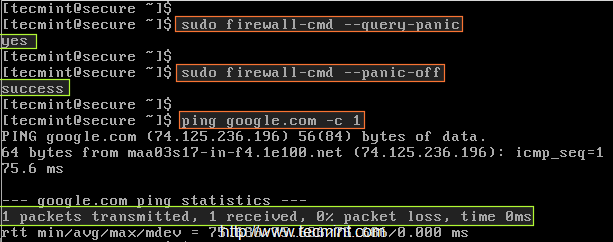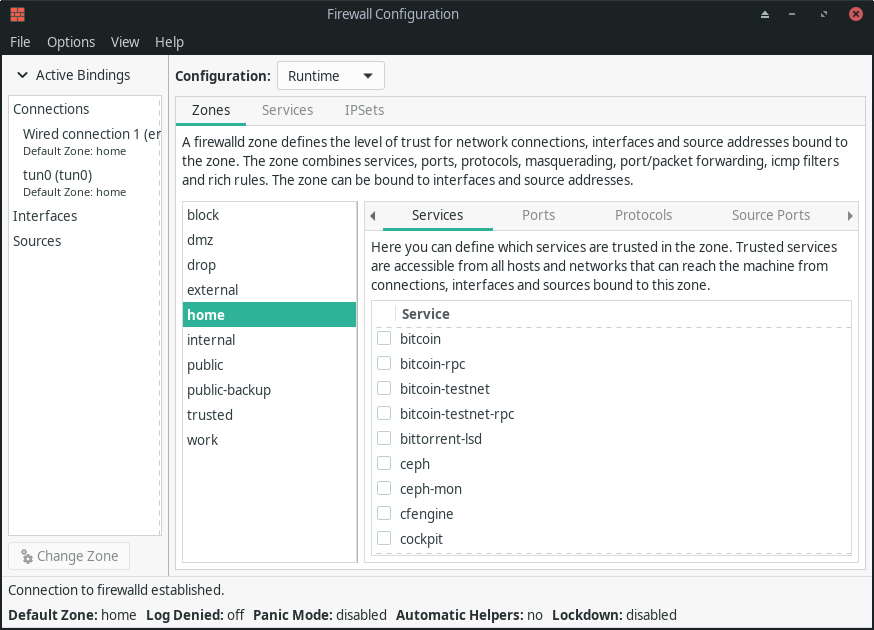
- #Firewallcmd panic mode install
- #Firewallcmd panic mode skin
- #Firewallcmd panic mode code
- #Firewallcmd panic mode plus
- #Firewallcmd panic mode series
The accepted answer is somewhat misleading as it talks about redefining the target destination 'DEFAULT'.
#Firewallcmd panic mode plus
'DEFAULT' is basically a simple REJECT plus other sane things for a more sensible default setting, its name choice is somewhat unlucky. The target in a zone is the destination target packets will be sent to if no other zone rules match, and can be zone drifting may be applied depending on global setting.if ingress zone is default, forwardings will follow egress zone target.On firewalld(1) and its targets as of 2020: For more details and complete documentation just take a look at. But in a nutshell, whatever you’d wish for in a firewall utility, you should be able to do it with firewalld. We’ve just scratched the surface of what you can do with firewalld. To get access to the machine again you you’d have to reboot the host or get local access and disable panic mode with: netbeez$ firewall-cmd -panic-off NOTE: if you are accessing the host remotely through ssh, enabling panic mode will also drop your ssh connection and you will lose access to it.

As the name suggests, if you are panicking that your system is compromised and you want to drop all connections, type: netbeez$ firewall-cmd -panic-on One unique feature of firewalld is enabling panic mode. To allow a specific port you can use a rule like the following: netbeez$ firewall-cmd -add-port=20018/tcp To remove a service use: netbeez$ firewall-cmd -remove-service=http To make them permanent, you can do the following: netbeez$ firewall-cmd -permanent -add-service=http Here is what services are listed if you restart the firewalld daemon: netbeez$ systemctl restart firewalldĪs you can see, http is not listed anymore. Now the http port 80 is allowed, but keep in mind that changes like these are not persistent if you restarter the firewalld daemon or reboot the system. RH-Satellite-6 amanda-client amanda-k5-client bacula bacula-client bgp bitcoin bitcoin-rpc bitcoin-testnet bitcoin-testnet-rpc ceph ceph-mon cfengine condor-collector ctdb dhcp dhcpv6 dhcpv6-client dns docker-registry docker-swarm dropbox-lansync elasticsearch freeipa-ldap freeipa-ldaps freeipa-replication freeipa-trust ftp ganglia-client ganglia-master git high-availability http https imap imaps ipp ipp-client ipsec irc ircs iscsi-target kadmin kerberos kibana klogin kpasswd kprop kshell ldap ldaps libvirt libvirt-tls managesieve mdns minidlna mosh mountd ms-wbt mssql murmur mysql nfs nfs3 nrpe ntp openvpn ovirt-imageio ovirt-storageconsole ovirt-vmconsole pmcd pmproxy pmwebapi pmwebapis pop3 pop3s postgresql privoxy proxy-dhcp ptp pulseaudio puppetmaster quassel radius redis rpc-bind rsh rsyncd samba samba-client sane sip sips smtp smtp-submission smtps snmp snmptrap spideroak-lansync squid ssh synergy syslog syslog-tls telnet tftp tftp-client tinc tor-socks transmission-client vdsm vnc-server wbem-https xmpp-bosh xmpp-client xmpp-local xmpp-server zabbix-agent zabbix-serverĪs you can see, only ssh and the dhcp client are currently allowed.Īs a first example, let’s enable http access on host with firewalld as follows: netbeez$ firewall-cmd -zone=public -add-service=http Like ufw, firewalld has a list of predefined services that you can use to specify rules, and you can get a list of all supported services with: netbeez$ firewall-cmd -get-services To see the current zone use: netbeez$ firewall-cmd -get-default-zone Out of the box, here are the available zones: netbeez$ firewall-cmd -list-all-zones

ssh), and another named “public” can include rules that block ssh (to prevent unwanted users trying to ssh to your machine) and you can obviously use it when in public unsecure networks. A zone is another word for a collection of firewall rules that you want to group together.įor example, you can name a zone “home” and in that zone include rules that open certain ports (e.g. One feature I like about firewalld is that it has the concept of “zones” inherent.
#Firewallcmd panic mode install
The easy way to install it with the following: apt install firewalld It’s pretty straightforward to install with the following command: Let’s see how it works with some examples. Both ufw and firewalld make iptables human-friendly and readable. After disabling panic mode established connections might work again, if panic.
#Firewallcmd panic mode code
įirewalld comes from the RHEL/CentOS universe but it’s available on Debian/Ubuntu as well. Code examples and tutorials for Ubuntu Cmd Firewall Give Access To Port.

#Firewallcmd panic mode skin
If you haven’t realized that there are already multiple ways to skin a cat on Linux, we are adding another firewall utility to our pocket: firewalld.
#Firewallcmd panic mode series
In our series Linux for Network Engineers we have covered the aspect of setting firewall and routing rules on a host at least two ways: iptables and a utility called ufw (uncomplicated firewall).


 0 kommentar(er)
0 kommentar(er)
